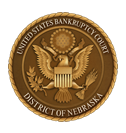- Form. A Chapter 13 plan must conform to Local Form NEB 3015-2(A).
- Employment of Debtor’s Attorney. The filing of the petition by an attorney constitutes an application by the attorney for employment in a Chapter 13 case, which is approved without further order unless a party in interest objects within 14 days of the filing of the petition.
- Employer Deduction. A Chapter 13 plan must include an employer wage deduction unless the court approves a motion establishing cause why an employer deduction should not be included.
- Pre-confirmation Adequate Protection and Lease Payments. Pre-confirmation adequate protection and lease payments under 11 U.S.C. § 1326(a)(1) must be paid inside the Chapter 13 plan through the trustee. For each payment, the plan must state the creditor’s name and address, the last 4 digits of the account number, payment due date, and payment amount. The debtor must immediately pay the trustee the amount necessary to pay all pre-confirmation payments plus statutory trustee's fees. The debtor cannot reduce plan payments to the trustee under 11 U.S.C. § 1326(a)(1)(B) and (C) without a court order. To change the amount of a pre-confirmation payment under 11 U.S.C. § 1326(a)(3), the debtor must file a motion. Until the motion is resolved, the trustee will pay the amount proposed in the plan.
The trustee may pay pre-confirmation payments in the proposed plan without a court order. A creditor will not be paid unless it files a proof of claim. The trustee will pay pre-confirmation payments within 30 days after a proof of claim is filed unless the debtor did not pay the trustee funds sufficient to allow the trustee to pay the claim within 7 business days before the 30-day period ends. The trustee must deduct from an allowed claim, as of the date of payment, each pre-confirmation payment the trustee makes.
If a creditor obtains an order for payment under 11 U.S.C. § 1326(a)(3) and the case is dismissed before a plan is confirmed, the trustee will pay the creditor any payments due and owing from funds collected by the trustee under 11 U.S.C. § 1326(a)(1)(A) less statutory trustee fees and allowed § 503(b) claims, including the debtor’s attorney fees.
- Notice of Chapter 13 Plan. No resistance deadline under Local Rule 9013-1(B) for a Chapter 13 plan may be earlier than 14 days after the meeting of creditors is concluded. If the debtor files the plan with the petition, instead of a specific calendar date, the 9013-1(B) notice may state: “Any resistance to the plan must be filed no later than 14 days after the meeting of creditors is concluded.” If the debtor does not file the plan with the petition, the resistance deadline must be a specific calendar date.
- Extension of Time to File Plan. If the debtor is granted an extension of time to file a Chapter 13 plan but does not file and notice the plan at least 14 days before the date set for the meeting of creditors, the trustee will reschedule the meeting of creditors. The debtor must serve notice of the rescheduled meeting on all parties in interest. If the plan is not filed at least 14 days before the second scheduled date, the trustee may file a notice stating the debtor did not comply and the case may be dismissed without further notice or hearing.
- Limited Motion to Modify Plan. After a Chapter 13 plan is confirmed, the debtor may cure payment delinquencies, abate future payments, or increase payments or the base amount of the plan by filing a limited motion to modify (Local Form NEB 3015-2(G). The limited motion cannot be used to permanently reduce plan payments, reduce the base amount of the plan, or reduce the term of the plan. If an objection to a limited motion is filed, the debtor must file a response within 14 days after the objection deadline. If the debtor does not timely file a response, the court may deny the motion. If the debtor files a response, the objection will proceed under Local Rule 3015-(3)(C).
- Discharge. Within 14 days after the trustee files a certificate of final payment, the debtor in a Chapter 13 case must file the certification regarding domestic support obligations and § 522(q) using official bankruptcy form B2830, or the case may be closed without a discharge.
